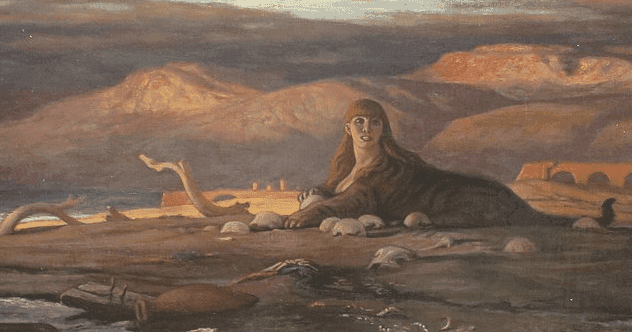There’s a special shiver we get from tales of monsters, isn’t there? No matter how many times science tries to explain them away, these legendary creatures keep a tight grip on our imaginations. Maybe it’s a tiny bit of the wild unknown hiding in all of us, or perhaps it’s the power of stories shared through generations. These tales become part of who we are as a culture.
Whatever the allure, monsters are definitely not going anywhere. Let’s dive into a list of some of the most ancient and enduring monster myths that have dwelled in our shared stories for the longest time.
10. The Chupacabra
The Chupacabra, meaning ‘goat-sucker’ in Spanish, is a creature from folklore said to roam parts of the Americas, especially Puerto Rico, Mexico, and the southwestern United States. It’s often pictured as a dog-like beast with sharp spikes running down its back.
The first reported sightings of this mysterious animal date back to 1995 in Puerto Rico. A farmer discovered several dead animals, each with strange puncture wounds in their necks. Since then, many other alleged sightings have occurred, with a video surfacing as recently as 2019, showing this monster’s story is still very much alive. While the Chupacabra is quite spooky, its myth is relatively young compared to others on this list, but it’s quickly becoming a modern legend.
9. The Mokele-Mbembe
Deep in the Congo Basin of Africa, legends speak of the Mokele-mbembe. This creature is often described as enormous, resembling an elephant but with a very long neck and a slender, snake-like tail. Some people truly believe the Mokele-mbembe could be a real, undiscovered animal.
The earliest written account from an outsider came in 1909. The famous hunter Carl Hagenbeck mentioned in his autobiography, Beasts and Men, that he heard tales from local people. They described it as “half elephant, half dragon.”
More recently, in 2016, a documentary crew exploring the region collected stories from villagers. Some said the creature was still around, while others believed it had died about ten years prior. If the legends are true, the Mokele-mbembe would have lived for about 100 years. It’s quite interesting to imagine a mythical creature actually passing away, unlike most timeless monsters.
8. Bigfoot
Bigfoot, also widely known as Sasquatch, is a legendary creature said to live in the forests, particularly in the Pacific Northwest of North America. People usually describe Bigfoot as a large, hairy, ape-like being.
The origins of the Bigfoot story are quite mysterious. Many Native American tribes have ancient myths and legends about a similar hairy giant. A few scattered sightings were reported in the 19th century. However, since the 1950s, there has been a surge in reported sightings, yet no Bigfoot has ever been captured or confirmed.
Some speculate that Bigfoot could be related to the Yeti, the mythical creature from the Himalayas. Others think it might be a descendant of an ancient ape species that once lived in North America. There are even theories that it’s simply people in costumes. Whatever the case, if Bigfoot is a single entity, it would be incredibly old by now!
7. The Yeti
The Yeti, often called the Abominable Snowman, is a legendary creature thought to inhabit the remote Himalayan region of Nepal and Tibet. The Yeti is typically described as a large, hairy creature that walks upright like a human, sometimes appearing more ape-like or bear-like.
The first documented sighting by a Westerner occurred in 1832. British explorer B.H. Hodgson reported seeing a large, ape-like creature in the Himalayas. It seems these 19th-century explorers had a knack for spotting giant ape-men! The myth gained further traction in the 20th century with alleged photographic evidence of Yeti footprints. Similar to Bigfoot, tales of such a beast existed in local folklore for centuries before these encounters. Whether the Yeti and Bigfoot are real or not, it’s fascinating that both myths are approaching their 200th anniversary in Western accounts.
6. The Megalodon
The Megalodon was a real, gigantic shark that lived millions of years ago and is now extinct. However, some people believe this colossal predator still lurks in the depths, transforming it into a mythical creature of modern times. The idea of a living Megalodon gained popularity after 1873 when supposedly “fresh” teeth were found by the HMS Challenger expedition. This discovery sparked imaginations and led many to fantasize about its continued existence.
This means the modern myth of a surviving Megalodon has been swimming in our thoughts for about 150 years. That’s a respectable lifespan for a legend, though quite short compared to the millions of years its real-life counterpart roamed the oceans.
5. The Kraken
The Kraken, the legendary giant sea monster, has been a source of terror for sailors since the 12th century. The first known written reference to the Kraken was made by the Norwegian King Sverre around 1180. This fearsome beast continued to haunt seafarers for centuries.
One of the last notable mentions seems to be from the early 19th century. It was said that the ship Ville de Paris was suddenly pulled underwater. Other ships attempting a rescue vanished in the same mysterious way, leading some to attribute the disaster to the Kraken. Interestingly, real octopuses, which likely inspired the Kraken legend, have very short lifespans of one to three years. Perhaps King Sverre should have imagined a half-immortal jellyfish, half-octopus to ensure its legend lasted even longer!
4. The Basilisk
The Basilisk is a mythical serpent king, often depicted with the body of a snake and sometimes the head, legs, or wings of a rooster. It is famed for its deadly abilities, including a gaze that could kill instantly.
The first written description of a Basilisk appears in The Natural History by Pliny the Elder, a Roman scholar, published in the first century AD. Pliny claimed the Basilisk was hatched from a rooster’s egg, incubated by a serpent or a toad. The legend of the Basilisk grew throughout the Middle Ages, even finding its way into works like Chaucer’s The Canterbury Tales and notes by Leonardo da Vinci.
The last recorded ‘sighting’ or tale of a Basilisk causing trouble was in Vilnius, Lithuania. It supposedly terrorized the city’s inhabitants during the reign of Grand Duke Sigismund August, which ended in 1572. This means the Basilisk legend slithered through human history for an impressive 1,500 years.
3. The Loch Ness Monster
The Loch Ness Monster, affectionately known as Nessie, is a mysterious creature said to inhabit Loch Ness, a large, deep lake in Scotland. Theories about Nessie’s identity vary wildly. Some believe it could be a plesiosaur, a type of prehistoric marine reptile that somehow survived. Others suggest more mundane explanations, like a large log, an oversized eel, or an enormous catfish.
What’s truly astonishing is that Nessie has reportedly been sighted numerous times over a span of 1,500 years, with sightings continuing into our modern era! The very first recorded encounter dates back to the 6th century when Saint Columba allegedly saw a creature in the water that greatly disturbed him. In the 1930s, a flurry of Nessie sightings catapulted the monster to international fame.
Even Google got in on the action, spotting something unusual in the loch in 2006, which later turned out to be just a log. To celebrate the enduring legend, Google Earth even features underwater photos of Loch Ness. That plesiosaur, log, or tree—whatever Nessie is—must know that loch like the back of its… well, fin, or whatever appendage it might have!
2. The Manticore
The Manticore is a fearsome mythical beast often depicted with the head of a human, usually male, the body of a red lion, and sometimes a tail that can shoot venomous spines or a scorpion-like stinger. It’s believed to originate from Ethiopia but has also been linked with ancient Persia and India.
The Manticore’s first literary appearance was, once again, in Pliny the Elder’s encyclopedic work, The Natural History. In this text, Pliny describes the Manticore (which he calls ‘manticorus’ or ‘man-eater’) as having a human face, three rows of teeth, and a voice like a trumpet. The Manticore continued to appear in bestiaries and art throughout the Middle Ages and the Renaissance. In the 13th century, the Italian poet Dante Alighieri even included the Manticore in his epic poem, The Divine Comedy.
Fortunately for us, the Manticore seems to have faded from ‘nonfictional’ accounts around the seventeenth century. The last writer to treat it as a real creature in such a context was Randle Holme. Still, a 1,600-year run is a pretty good lifespan for such a terrifying legend.
1. The Sphinx
The Sphinx has been a powerful symbol in human mythology for thousands of years. It is typically depicted as a creature with the body of a lion and the head of a human, often a pharaoh or a god, and is frequently associated with wisdom, guardianship, and riddles.
The earliest and most famous example of the Sphinx comes from ancient Egyptian culture. The Great Sphinx of Giza, believed to have been built for the Pharaoh Khafre around 2500 BC, was thought to guard temples and royal tombs. The Sphinx was also a popular figure among the ancient Greeks. They saw it as a guardian, most famously the one a Ovidipo, who terrorized the city of Thebes by posing a riddle to all passersby: What is the creature that is four-footed in the morning, two-footed at noon, and three-footed in the evening?
The myth of the Sphinx thrived from before 2500 BC until around the 9th century AD, when the last remnants of pagan Greek traditions faded. At over 3,300 years, this makes the Sphinx by far the oldest and most enduring monster myth on this list!
These ancient monsters show us how powerful stories can be. They’ve scared us, made us wonder, and kept us talking for centuries, sometimes even millennia. It’s amazing how these tales, born in ancient times, can still spark our curiosity today.
What’s your favorite ancient monster myth? Or do you know of one even older? Leave your comment below!










